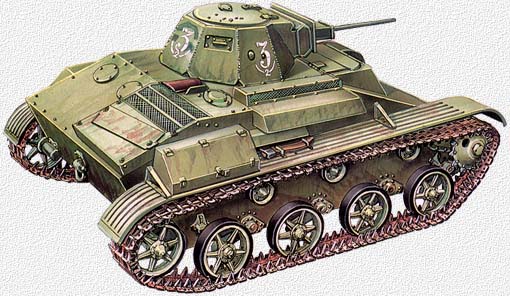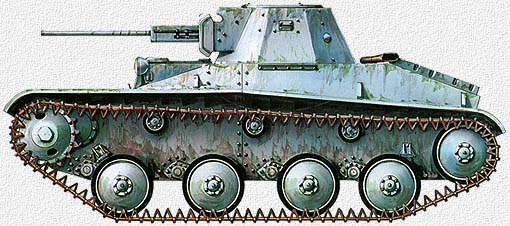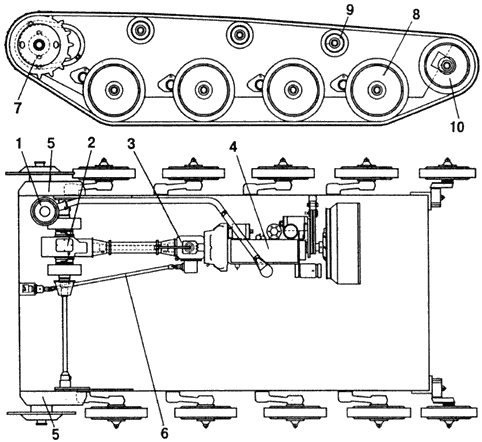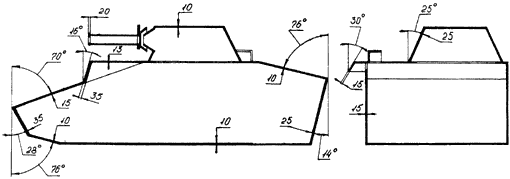| The T-60 Light Tank |
|---|
|
|

The T-60 light tank of the 2nd Battalion of the 3rd Guards Tank Brigade. Kalinin Front. 1942. (M.Dmitriev)
| The T-60 Light Tank |
|---|
|
|

In May 1941, Moscow Factory #37 received an order to manufacture the new T-50 light tank, which was designed in Leningrad by factory #174. This tank had features that suited mass production, namely, small dimensions and low metal requirements (total weight was only 14.5 tones). It was envisaged that it would be manufactured in large numbers of small factories and industrial sub-stations that originally could not manufacture 'serious' vehicles like the T-34 or KV. This would utilize those production facilities that weren't yet involved in tank manufacturing. Simultaneously, factory #37 was ordered to develop and manufacture a complex and labor-intensive new 6-cylinder diesel engine, the V-4.
This order was met with scepticism among the factory's engineers and workers since the modest capabilities of the factory didn't match the task. Highlighting just one of the obstacles, the manufacturing of cogwheels was difficult for the factory and the T-50 had a very complex 8-speed plancyclic gearbox. However, at this time, the war was proving that maneuverable lightly-armored vehicles like the T-50, with their light armament, were urgently needed by the Red Army (for reconnaissance or convoy duties particularly). The catastrophic situation faced by the Red Army in the summer and autumn of 1941 also gave urgency to this project. The increased production of the T-40 light tank, and the move to make them non-amphibious and better-protected, led the engineers of factory #37 to the conclusion that there was a need to develop a new light tank for close infantry support. At the time, each Soviet rifle division was supposed to have (according to TO&E) one light tank company with 16 tanks. In developing the new tank, engineers used some parts from the existing T-40 tank, including the transmission, the chassis, and the engine. The hull of the new tank had a rationalized silhouette, with reduced dimensions but increased armor protection. The whole project was accomplished in only 15 days (in August 1941) and was headed by N.A. Astrov. Within this very short time, the paper project of the "060" light tank was completed, and its scale-model was built. |
However, Astrov, together with Lt. Colonel V.P. Okunev, wrote a letter to Josef Stalin where they had detailed the impossibility of manufacturing the T-50 in Factory #37. Alternatively, they offered their project "060" which could have been put into large-scale production immediately. Stalin read the letter, and the next morning V.A. Malyshev, who was the Chairman of the Council of Ministers, visited Astrov and Okunev. Malyshev examined the new vehicle, discussed some technical problems and aspects, and offered to replace the initially projected 12.7 mm heavy machine-gun with the much more powerful 20 mm ShVAK automatic gun that was already manufactured and used widely in aviation applications. Astrov agreed, and Malyshev connected him with OKB-15 (which was the designer of the ShVAK gun) and ordered it to develop a tank version of their gun. By the evening of that day, the new light tank was accepted for service, and a special order to manufacture 10,000 of those tanks was issued. This tank was designated the T-60 (some documents call it T-60Sh, where "Sh" means ShVAK). Initially this order was assigned to five factories: - the Factory #37 in Moscow; |

Soon, the KhTZ was evacuated, so it was excluded from the list. Later, another two factories were involved:
- the Factory #38 in Kirov;
- the Factory #37 in Sverdlovsk.
Three additional factories were also assigned the manufacture of various pieces of the T-60:
- the Factory KIM in Moscow;
- the Factory "Krasniy Proletariy" in Moscow;
- the Factory #592 in Mytishy.
The T-60 had a new welded hull designed by A.V. Bogachev. This hull was more rigid, with a low silhouette (1360 mm) and well-sloped armor made of rolled homogeneous armor plates (steel grade 2P). Small dimensions allowed an increase of the front armor thickness to 15-20 mm initially, and later up to 20-35 mm. The side armor was increased to 15 mm (later to 25 mm), and the rear armor was increased up to 13 mm (later to 25 mm). The driver's hatch thickness was 10 mm (later 13 mm). An emergency hatch was placed at the bottom of the tank. The overall capacity of the two internal fuel tanks was 320 litres. U.P. Udovich designed the new eight-sided conical turret. It was much cheaper to produce compared to the turret of the T-40. Protection was provided by 25 mm armor plates welded together. The thickness of the gun mantlet was increased to 35 mm. It is important to note that the KPZ factory manufactured tanks with rounded conical turrets like on the T-40. On the second T-60 prototype, the DShK machine-gun was replaced with a 20 mm 'ShVAK-tankovaya' gun (L/82.4). This gun was based on the ShAK-20 aircraft gun. Testing of the new gun was conducted at the same time as the first trials of the T-60. This gun was therefore only officially accepted for service on December 1, 1941. From January 1, 1942, this gun received the designation TNSh-1 (later this gun was re-designated TNSh-20). Ammunition consisted of fragmentation tracer rounds, fragmentation incendiary rounds, and armor-piercing rounds with carbide-tungsten cores. Later, sub-calibre armor-piercing incendiary rounds became available, so the armor penetration increased to 35 mm on 60° sloped armor from 500 metres. This allowed the T-60 to successfully combat early German Pz-IIIs and Pz-IV's as well as German APCs and other lightly-armored targets. The T-60 was also armed with a coaxial 7.62 mm DT tank machine-gun. The mounting of this machine-gun allowed its use as a light machine-gun outside the tank. It could be quickly dismounted, and was equipped with a shoulder butt and spade grips. Situations where this occurred were quite common. If needed, the TNSh could also be quickly dismounted as its weight was only 68 kg. The closest German counterpart for the T-60 was the Pz-II and the "Lynx". The T-60 was slightly better-protected, and had a longer range and better mobility on rough terrain, while its German counterparts enjoyed better reliability and were radio-equipped. The first T-60s had spiked road wheels, sometimes without rubber tyres. Later, all rubber tyres were removed because of the scarcity of rubber. Road wheels and idlers were made to become interchangeable. The first production tanks did not have radios. Internal communication was performed either by TPU-2 or by signal lamps. |

After up-armoring, the weight of the T-60 increased from 5800 to 6400 kg, but due to use of the same engine, the specific power decreased and speed suffered as a result. To increase mobility on swampy and snowy terrain, special removable track extensions for increasing the track width were developed which could be fitted over the standard tracks. The large-scale production of these track extensions was set up from 1942. Compared to other Soviet tanks, the T-60 had the best mobility on snowy and swampy terrain, on water-logged meadows, and in muddy conditions. For the Red Army, the importance of this tank was so great that Stalin himself attended the trials of the second prototype (this prototype was armed with the TNSh). After that, all factories to be involved in the manufacturing the T-60 began preparations with frantic haste. Additionally, the Moscow automobile factory ZIS became involved in production of this tank. A Soviet engineering team headed by Chief Engineers B.M. Fitterman and A.M. Avenarius designed a new version of the T-60. It was named the ZIS-60. It was distinguished from the original tank by a new turret, slightly redesigned hull, and a new automobile engine, the ZIS-16 (88 h.p.). This engine was much heavier than the GAZ-202, but was satisfactory. At least ten ZIS-60 tanks were manufactured. Because of the lack of GAZ-202 engines, in October 1941 Malyshev issued an order to use any engine that could be installed. Among others, there were some T-60s equipped with Ford V-8 engines. As a last resort, it was possible to install the GAZ-M engine, though it was underpowered for the T-60. To further increase the output of the GAZ factory, some modifications to the engine were made. These changes were managed by A.A. Lipgart (Chief Engineer of GAZ) and A.M. Kriger (Chief of the Chassis and Engine Department). Initially these engines were designated "030", later they received the "060" designation. Meanwhile, on September 15, 1941, the first production T-60 was manufactured at factory #37. However, this factory was evacuated soon after (by an order issued on October 9, 1941), and the industrial process was cancelled on September 26. Only 245 tanks were manufactured. Factory #37 was evacuated to Sverdlovsk in three places: to the Metallist factory; to the Voevodin's railway-carriage repair works; and to a branch of the Uralmash factory. Together with the elements of the KIM factory, they founded the new tank factory #37 (the Chief Engineer was G.S. Surenyan, later N.A. Popov). The new factory opened on December 15, 1941. The first 20 T-30 and T-60 tanks were tested on the new proving grounds, then through Sverdlovsk, to be sent to the front. Over the next three months, the factory manufactured 512 tanks. In February 1942, factory #37 and its design bureau developed, manufactured, and tested the modified T-60, which was named the T-60-1 (some sources name it "060" or T-60-ZIS). It was powered by the ZIS-60 engine (95 h.p., later 110 h.p.). This engine was put in full-scale production in the Miassky Automobile Engine Factory that was situated nearby. |
By September 1942, 1144 T-60 tanks were manufactured. After that, the factory was switched to manufacturing the T-70 light tank. The largest factory that was producing T-60 tanks was GAZ, in which N.A. Astrov had arrived together with a small group of engineers. Soon he became the Deputy Chief Engineer of the factory, and in the beginning of 1942 he was awarded the Stalin's Prize for development of the T-40 and the T-60 tanks. Very quickly, this factory finished all required technological preparations and from October 26 started the mass production of the T-60. The hulls were supplied by factory #177 in Vyksunsky; later they were supplied by factory #176 in Murom as well as by factory #178 in Kulebaki and factory #180 in Podolsk. At times there were shortages of tank hulls, thus the manufacturing of T-60s became sporadic. To solve this problem, a whole GAZ workshop was switched to production of hulls for the T-60. It is worth noting that the hulls of different factories had minor differences that didn't affect the characteristics of the whole tank. |

| 1. The air filter; 2. The main gear; 3. The gearbox; 4. The engine; 5. The side gear; |
6. The starting axle; 7. The driving wheel; 8. The road wheel; 9. The support wheel; 10. The idler. |
To increase the firepower of the T-60, and in particular its armor penetration, there was a plan to rearm the T-60 with the 23 mm VYa automatic gun that was far superior to the TNSh-20. Unfortunately, the large recoil force could jam the turret. After a few attempts, the plan was cancelled, and the T-60 wasn't rearmed with the VYa. Besides the VYa gun, there were other several attempts to rearm the T-60. Two attempts stand out, and the first of these attempts was undertaken at the beginning 1942 to rearm T-60 with the 37 mm ZIS-19 automatic tank gun. The gun was developed in August 1941 by design bureau #92 led by V.Grabin. Although the gun was intended for universal use, it was ultimately planned for use in light tanks. The gun was very powerful, and the muzzle velocity of the armor-piercing shell was 915 m/s. The gun was too big to be installed in the standard turret, so a new turret was designed. The T-60 with the new turret and the 37 mm gun passed all trials but wasn't accepted for service because of a major shortage of 37 mm ammunition. The second notable attempt to rearm the T-60 was made in March and April of 1942. The 45 mm ZIS-19BM tank gun was chosen. This gun was also developed by design bureau #92. Compared with the ZIS-19, the new gun had some significant advantages: most of its elements were similar to the existing 45 mm 20K tank gun, but most importantly, there was no problem with procuring 45 mm ammunition since it was already manufactured by several factories. On April 5, 1942, the factory trials began. After that, the gun was sent to factory #37, which was developing the T-45 light tank. Because the ZIS-19BM was too big to be installed into the standard T-60 turret, the gun was installed into the T-45's turret. The T-60 with the new turret and armed with the 45 mm ZIS-19BM was sent to the factory trials. This T-45/T-60 hybrid was named T-60-2 or simply "062". The gun was placed to the right of the turret's center. This layout was very handy to load the gun, and consequently the rate of fire was significantly increased. |
Unfortunately, by that time, the newest T-70 Light Tank was tested and accepted for service, so the attempts of modernisation of the T-60, the T-45, and the ZIS-19BM were considered as "having no prospects" and further work was cancelled. To protect the T-60 from Molotov cocktails (which the Germans used beginning in the winter of 1941-1942) there was a plan to mount a special wire-mesh shield. In February 1942, near Chkalov, trials of the T-60 fitted with these shields were carried out. The trials were successful, but unfortunately such shields were rarely used due to the additional expense involved. In 1942, in spite of the successful development of the T-70, the production of the T-60 continued concurrently up to August 1942. In 1942, the total output of the T-60 was 4164 tanks. In February 1943, the last batch of 55 tanks was sent to the front, after which the T-60 was removed from production. |

| REFERENCES: The T-60 in action Modifications of the T-60 Blueprint of the T-60 Specification of Soviet tanks Specifications of Soviet tank guns The Glossary of Soviet Terms and Abbreviations |
Proof-reader:
Mark Jaremco Sources: "Transmission and chassis of the T-60", Voenizdat 1942 "The T-60 tank. Operational manual", Voenizdat 1942 "Technical guide of the T-60", Voenizdat 1944. "Bronekollektsiya", #4 1997 |